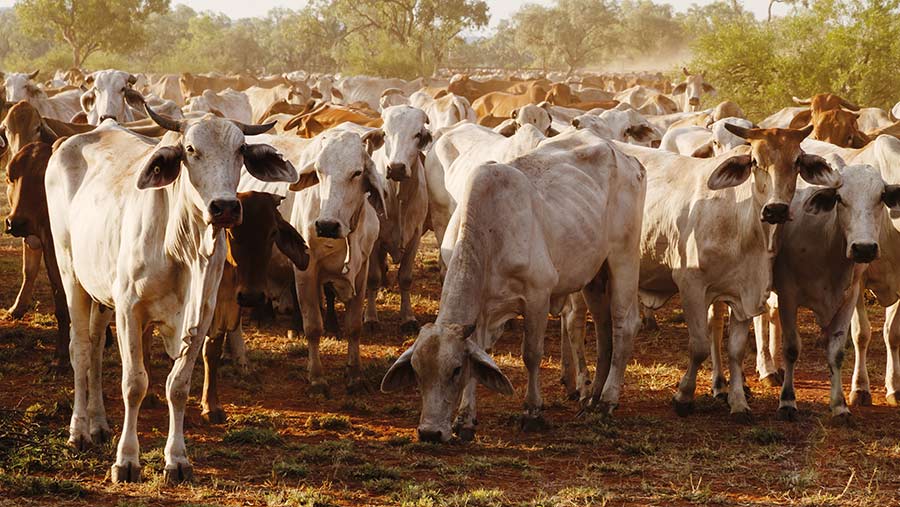Australian trade deal: Opportunities and threats to UK farmers
 © Austrianimages/Adobe Stock
© Austrianimages/Adobe Stock The post-Brexit free trade agreement between Britain and Australia offers a mix of threats and opportunities for UK farmers, according to an AHDB report.
The levy board’s Horizon Report is its first in-depth analysis of the deal, agreed in June, and its potential impact on British farming.
AHDB head of strategic insight David Swales explained that the deal was the first since Brexit to be negotiated from scratch and could set a template for others.
See also: UK signs Australia free trade deal despite farmer concerns
“Trade deals always cause a great deal of debate, with predictions of either untold benefits or devastating impacts,” he said.
Speculation over the UK-Australia deal had been raised since both governments decided to withhold impact assessments due to the sensitivity of detail, he added.
But Mr Swales said the AHDB wanted to provide an evidence-based, sector-by-sector breakdown of the opportunities and risks to farming (see below).
Overall impact
Overall, the scale of Australian farming means it can produce food cheaply and there is limited scope for UK producers to compete at a commodity level, Mr Swales noted.
But he stressed that suggestions that the UK will be flooded with low-cost agricultural products may prove inaccurate.
At least in the short term, Australian exports to the UK may be subdued due to more lucrative and rapidly expanding markets such as China.
However, the global situation is complex and more prone to volatility than the previous stability of the EU market.
“We may not see an immediate impact today or tomorrow from the doors of trade being flung open. Yet, further down the line, changes to markets have the potential for harmful consequences to our agricultural marketplace,” Mr Swales said.
Trade prospects by sector
Lamb
Australia is a substantial producer of lamb, at 722,000t a year compared with the UK’s 299,000t annual output.
The AHDB model predicts that there could be an 81% increase in UK imports.
That equates to just an extra 10,000t which would directly displace EU imports and pose little threat to UK prices.
But future price concerns surround Australia’s relationship with China, which imported 180,000t of Australian sheep meat in 2019.
Political tensions are escalating between the two countries and tariffs or bans could see the UK’s market targeted.
Beef
At 2.3m tonnes a year Australia’s beef production is more than double that of the UK. With a small domestic market, Australia exports about 1.4m tonnes each year.
The analysis suggests Australia will continue to prioritise the US and Japan. Imports to the UK will rise by just 12,000t, with selling mainly of premium cuts for catering which will compete on price with British produce.
Retail markets will be tougher to crack with the UK major outlets largely supportive of British product.
Any lower-quality cuts would face strong competition from Irish product. Also, a forecast expansion of Australia’s cattle herd represents a threat of cheap meat challenging our market.
Dairy
Australia’s liquid milk production has declined over a decade to 9.2m tonnes.
Therefore, it is a net-importer of dairy products, mainly supplied by New Zealand. The US and certain EU countries are also major suppliers.
Currently, the UK sends only a small amount at £8m of cheese and £2m of butter.
The AHDB analysis suggests the trade deal could offer an opportunity for UK exporters. The UK could also challenge for some of Australia’s current Asian markets as future trade deals are struck.
Pig meat
Australia’s pig meat sector is relatively small at 410,000t produced each year. It is a net importer of pig meat.
Only a few selected countries export to Australia and these share a market worth £368m a year.
The new trade deal could represent an opportunity for the British sector. Any trade will be carefully controlled by Australia’s strict sanitary laws.
Wheat
Australia produces 17.9m tonnes of wheat a year compared with the UK’s 14.9m tonnes. But exports account for 70% of output at 11.8m tonnes.
Much of the tonnage is used as a top-up for markets in the northern hemisphere due to the timing of the harvest.
Severe drought has pushed up Australian wheat prices to about £198/t, making it less competitive.
Barley
Australia is a net exporter of barley with 40% of its 9.8m tonne crop shipped abroad. The main destination is China, which accounts for 70% of the export total.
However, China has imposed an 80.5% tariff on barley exports. Australia has been forced to look elsewhere for markets, such as Africa and Saudi Arabia.
This is a concern for the UK, which targets these countries as outlets when there is a domestic surplus.
How the deal will benefit Australian farmers
Beef
- Immediate duty-free quota of 35,000t, rising to 110,000t then tariffs eliminated after 10 years
- Further volume threshold to apply, rising to 170,000t, with a 20% tariff applied to anything above this over next five years
Sheep
- Immediate duty-free quota of 25,000t, rising to 75,000t, then tariffs eliminated after 10 years
- Further volume threshold to apply, rising to 125,000t, with a 20% tariff applied to anything above this over next five years
Dairy
- Immediate duty-free quota for cheese of 24,000t, rising to 48,000t in year five. Tariffs eliminated over five years.
